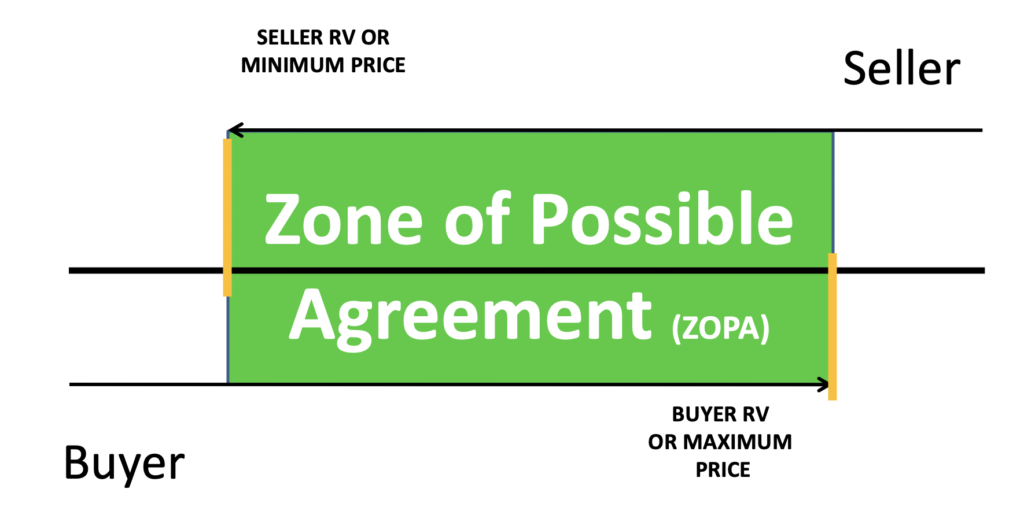Markets across Canada are proving to be inconsistent at best and chaotic in general. Some properties are selling in multiple offers while others don’t get any interest at all. Some agents are making deals and others, not so much. To be in the deal flow in the emerging market, you’ll need sharp negotiation skills, smart strategies and an open mind. It takes more than having a bunch of leads to get deals done now.
One tool that my clients are using more than in the past is the ZOPA tool. It’s an acronym for Zone Of Possible Agreement and it’s a valuable tool to determine the mathematical decisions around offers and counter offers. It doesn’t work in a strong seller’s market where there are competitive bids taking the sale price above the asking price but anytime that there is a back and forth between Seller and Buyer over price, it can be a good way to build an offer and counter offer strategy.
It’s based on the psychological effect of the midpoint rule. Many people calculate the mid-point between numbers to estimate where final price might fall. They may not share this thought with anyone and in fact, they may not even be aware that they are making this calculation but it often has a significant impact on what they believe to be fair and acceptable.
As the markets change from a strong sellers’ markets to either a balanced, or buyers’ markets, the psychology around negotiations will need to change as well. Much of Canada has seen a predominate seller’s market for the better part of 12 years so many agents have no experience with anything else. It’s hard to know what you don’t know. The agents who will be in the deal flow are the ones that can switch their thinking to adapt to the current market conditions.
Let’s take an example of the midpoint rule. You have a listing at $690,000 and it hasn’t had much interest. The sellers lowers the price to $659,000 and while you get a few calls and a couple of showings, no offers or serious interest. Then an agent calls saying she has an investor client who would like to make an offer of $600,000 and didn’t want to waste their time unless your seller is negotiable. You may feel that this offer is far too low and dismiss the agent but it is worth considering what the mid-point is and if this might be something your seller might be able to accept. The midpoint is $630,000 and if the market it currently balanced or favouring the buyers, this may be a fair price for the property. There is no way to know if the buyers would be willing to go to this price but there is a strong possibility that they determined their offer based on the midpoint rule. Here’s the tricky part; the agent and possibly even the buyer may not know that they are willing to go to that price so as the listing agent, you want to play to that psychology. If you ask the buyers’ agent they are likely to say no because they believe that to be true. Instead say, “yes, bring the offer” but don’t say too much more other than building relationship with the buyer’s agent. “Let’s work together and see if we can get this deal done” might be something that could build collaboration and increase the odds of getting a deal done.
If you have taken the MCNE courses, you have learned the ZOPA tool and it may be necessary to revisit it. Here is a quick review. (Click HERE to download the ZOPA worksheet)
The price between the Seller’s minimum and the Buyer’s maximum is known as the Zopa. If there is no Zopa, there is no deal and it’s best to abandon the negotiations and find a different property or a different buyer. The min and max are estimates so it’s tricky to know for sure when to abandon. The Zopa work sheet, pictured below gives you lines that you can calculate what the midpoint is for each offer or counter offer. The rule of thumb for the initial offer from a buyer is just below zopa and still justifiable. You’ll also want to consider what the midpoint is between the asking price and the offering price.
As you decide on each counter offer, you want to consider the midpoint and if it will be advantageous to your clients. The buyer wants the lower part of Zopa and the Seller wants the higher part of Zopa and your job is to do the best for your client.
Your negotiations may benefit by allowing some time between counter offers for the other side to consider their options. What feels impossible tonight may be more appealing after a sleepless night. Be patient and persistent but remain collaborative and you may find that putting deals together in the new emerging market is both challenging and rewarding.

